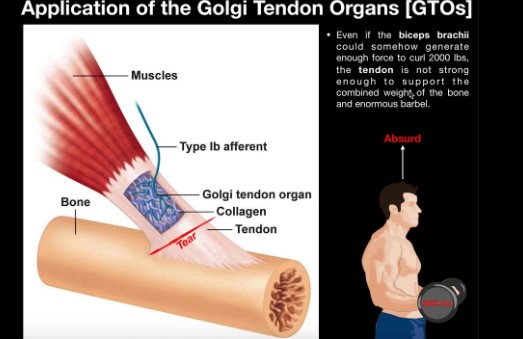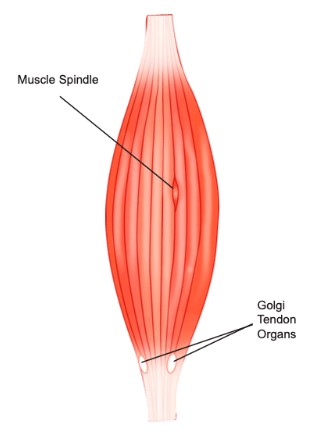Proprioception, often referred to as the “sixth sense,” plays a pivotal role in human movement and balance. It encompasses the body’s ability to sense its position, movement, and action without relying on visual cues. At the heart of this complex sensory system lie two key proprioceptors: the Muscle Spindles and Golgi Tendon Organs. Each serves a unique function in monitoring and regulating muscle activity, ensuring our movements are smooth and coordinated.
The difference between Muscle Spindles and Golgi Tendon Organs lies primarily in their location and function. Muscle Spindles, located within the muscle fibers, are sensitive to changes in muscle length and initiate a contraction to prevent overstretching. On the other hand, Golgi Tendon Organs are found at the junctions between muscles and tendons, detecting tension within muscles to prevent excessive contraction by inhibiting further muscle activation.
Understanding the distinct roles of Muscle Spindles and Golgi Tendon Organs is essential for comprehending how the body maintains posture, balance, and coordinated movement. Their intricate functions contribute to our ability to perform everyday activities and athletic feats, highlighting the remarkable adaptability and complexity of the human body.

Basics of Proprioception
Definition and Importance
Proprioception is our body’s ability to sense its position, movement, and action in space. It acts as our internal GPS, providing constant feedback to our brain about our limbs’ positions without us needing to look at them. This sensory system is essential for everyday activities like walking, writing, and even standing still.
Role in Movement and Balance
Proprioception enables us to move smoothly and maintain our balance by adjusting our muscles’ actions based on the feedback received from proprioceptors. It’s crucial for:
- Coordinating movements: Whether it’s typing on a keyboard or sprinting, proprioception allows our muscles to work together seamlessly.
- Maintaining balance: It helps us adjust our posture to avoid falls, especially on uneven surfaces.
- Learning new skills: From riding a bicycle to learning a dance, proprioception is key to mastering movements.
Muscle Spindles
Structure
Location in Muscles
Muscle Spindles are embedded within the belly of muscles, intertwined among the muscle fibers. They are particularly abundant in muscles that require fine control, like those in the hands and eyes.
Composition and Features
Each Muscle Spindle consists of intrafusal fibers (specialized muscle fibers), surrounded by a capsule. These fibers are innervated by sensory and motor neurons, making them sensitive to changes in muscle length.
Function
Stretch Reflex Mechanism
When a muscle stretches unexpectedly, Muscle Spindles trigger a reflex contraction of the muscle, known as the stretch reflex. This mechanism helps prevent muscle damage from overstretching.
Role in Muscle Tone Regulation
Muscle Spindles play a critical role in maintaining muscle tone, the constant tension in muscles necessary for posture and movement.
Golgi Tendon Organs
Structure
Location at Muscle-Tendon Junctions
Golgi Tendon Organs are located where the muscle fibers connect to the tendons, at the muscle-tendon junctions. This strategic placement allows them to monitor the tension generated in the muscles.
Composition and Characteristics
Composed of sensory nerve endings interwoven among the collagen fibers of the tendon, Golgi Tendon Organs detect changes in muscle tension, converting this mechanical information into neural signals sent to the brain.
Function
Inhibition Reflex Mechanism
When excessive tension is detected, Golgi Tendon Organs activate an inhibitory reflex that relaxes the muscle, thereby preventing potential damage from overexertion.
Contribution to Force Regulation
By regulating muscle tension, Golgi Tendon Organs ensure that force is applied smoothly during movements, preventing injury and facilitating controlled actions.

Comparative Analysis
Sensory Feedback
Differentiating Sensory Inputs
Muscle Spindles and Golgi Tendon Organs provide unique sensory feedback crucial for movement and posture. Muscle Spindles detect changes in muscle length (stretch), signaling the need to contract the muscle to prevent overstretching. Conversely, Golgi Tendon Organs monitor tension within the muscle-tendon unit, inhibiting muscle contraction to prevent excessive tension that could lead to injury. This complementary feedback ensures a balanced and protective response to physical demands.
Reflex Arcs
Contrast in Reflex Pathways
The reflex pathways of Muscle Spindles and Golgi Tendon Organs illustrate their distinct roles. Muscle Spindles initiate the stretch reflex, a direct loop where sensory neurons stimulate motor neurons, leading to immediate muscle contraction. In contrast, Golgi Tendon Organs are part of the inhibitory reflex arc, where sensory input results in the inhibition of motor neurons, causing muscle relaxation. These pathways demonstrate how the body seamlessly integrates sensory information to maintain muscle integrity and function.
Functional Roles
Complementary Functions in Movement
Muscle Spindles and Golgi Tendon Organs offer complementary functions in movement and balance. While Muscle Spindles facilitate quick adjustments to unexpected stretches, ensuring agility and precision, Golgi Tendon Organs moderate force generation, providing a safeguard against potential overexertion. Their synchronized action is pivotal for executing complex movements, from the delicate tasks performed by musicians and surgeons to the explosive power displayed by athletes.
Implications in Physical Activities
Influence on Strength Training
In strength training, understanding the role of these proprioceptors can enhance performance and safety. For instance, slow, controlled movements activate Muscle Spindles, promoting muscle growth and coordination. Recognizing the importance of rest and gradual progression takes into account the protective feedback from Golgi Tendon Organs, preventing overtraining and injury.
Impact on Flexibility and Stretching
Flexibility and stretching exercises are greatly influenced by Muscle Spindles and Golgi Tendon Organs. Techniques such as static stretching can decrease Muscle Spindle activity over time, increasing muscle length and flexibility. Conversely, dynamic stretching stimulates these proprioceptors, warming up the muscles and preparing them for activity, showcasing the importance of tailored stretching routines in physical training.
Applications in Rehabilitation
In rehabilitation, leveraging the functions of Muscle Spindles and Golgi Tendon Organs can accelerate recovery and prevent future injuries. Exercises designed to retrain proprioceptive feedback can help restore muscle function and balance after injury or surgery. This approach underscores the need for comprehensive rehabilitation programs that address the nuanced roles of these proprioceptors in muscle recovery and conditioning.
Research Insights
Recent Studies on Proprioception
Recent studies have shed light on the advanced mechanisms of proprioception and its critical role in motor control and sensory integration. Investigations into the plasticity of proprioceptive signals offer promising implications for rehabilitative strategies, suggesting that targeted training can enhance proprioceptive acuity and muscle control, potentially transforming approaches to injury recovery and athletic training.
Advanced Understanding of Muscle Control
The advanced understanding of muscle control facilitated by recent research has profound implications for medical practice and sports science. By elucidating the intricate interactions between Muscle Spindles and Golgi Tendon Organs, scientists and practitioners can develop more effective treatments and training programs that respect the body’s natural mechanisms for maintaining balance and movement efficiency.
FAQs
How do Muscle Spindles Work?
Muscle Spindles respond to changes in muscle length by sending signals to the spinal cord, which then initiates an immediate muscle contraction to counteract the stretching. This reflex action, known as the stretch reflex, helps in maintaining muscle tone and posture by adjusting the muscle’s length in response to movement.
What is the Function of Golgi Tendon Organs?
Golgi Tendon Organs serve to prevent muscle damage due to excessive force by inhibiting muscle contraction when excessive tension is detected. This feedback mechanism ensures muscle force is regulated, protecting the muscle and tendon from potential injury.
Can the Sensitivity of Muscle Spindles and Golgi Tendon Organs be Altered?
Yes, the sensitivity of both Muscle Spindles and Golgi Tendon Organs can be altered through specific types of training, such as strength training and flexibility exercises. This adaptation can enhance performance by improving the efficiency of reflex actions and the body’s ability to regulate muscle tension.
Why is Proprioception Important for Athletes?
Proprioception is crucial for athletes as it affects balance, coordination, and the ability to respond to rapid changes in the environment. Enhanced proprioceptive abilities can lead to improved performance, reduced injury risk, and faster recovery from injuries.
Conclusion
The intricate dance between Muscle Spindles and Golgi Tendon Organs is fundamental to our ability to move, react, and interact with the world around us. These proprioceptors not only safeguard our muscles and tendons from injury but also facilitate the smooth execution of movements, from the mundane to the extraordinary. Their harmonious operation exemplifies the body’s sophisticated mechanisms for maintaining balance, posture, and coordination, underscoring the marvel of human physiology.
The appreciation and understanding of these mechanisms extend beyond academic curiosity, offering practical insights for athletes, coaches, and therapists. By harnessing knowledge about Muscle Spindles and Golgi Tendon Organs, professionals can develop training and rehabilitation programs that optimize performance and expedite recovery, demonstrating the profound impact of proprioception on physical health and capabilities.

